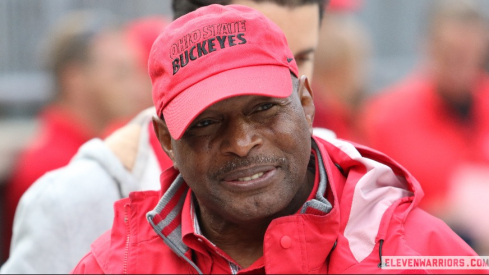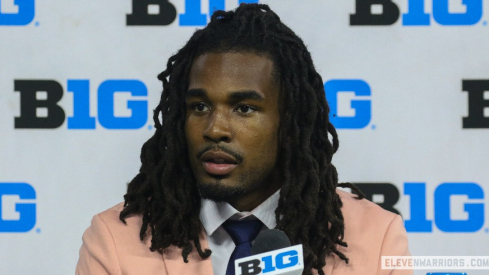
It is difficult to draw any conclusion from the Ohio State offensive performance against UAB other than another hot and cold effort from the OSU offense. The Buckeyes had flashes of brilliance but also periods of ineptness. The OSU offense came out sloppy, missing early opportunities with missed blocks, dropped passes, and the like. And yet, upon further viewing, it became clear that the Buckeye offense purposefully handcuffed itself against the Blazers. This refers not just to scheme, but more importantly to limiting Braxton Miller's runs. The Ohio State offense burned hot because whenever UAB came within breathing distance, Miller employed his legs, opening up everything for the Ohio State offense.
AN underdog Approach
UAB adopted a high risk/high reward approach consistent with their underdog role. Specifically, UAB used their slot defender (but also at times a corner) to crash down and account for the quarterback in the run game. In so doing, UAB hoped to a) confuse Braxton Miller's reads and b) change the arithmetic against the OSU run game. In the clip below, UAB blitzes their corner, putting 8 defenders in the run game and playing cover 0 behind. A nice run by Jordan Hall negates this advantage, but reflects UAB's general strategy.
The Buckeyes were not able to take advantage early, however, because of sloppy play. As Urban Meyer discussed, OSU's first play was a 3-verticals pass to Devin Smith. Smith was open, but Andrew Norwell missed his block, forcing Braxton to throw early and long. Norwell repeatedly had problems early diagnosing his blocking assignments. He would look inside, even though UAB was bringing two edge rushers, requiring the tackle and guard to step outside to pick up the wide rush. The malaise of one of OSU's top linemen reflected a fairly flat effort by OSU in the opening stanza.
Constraint?
The natural response for Ohio State to a team that cheats their alley player against a spread team is to throw bubble and flash screens.

It is a common action and reaction. Defenses want to cheat a defender into the box to restore the numbers advantage against an offense with a QB run threat. The WR screen works as a constraint against a team cheating a backside defender against the zone read. A team that does not respect the wide receivers renders the spread a liability, not an asset, because an offense has fewer blockers at the point of attack. Yet Ohio State did not do so one time. I have a hard time believing that Urban Meyer and Tom Herman somehow forgot the offense they have run for years. The natural conclusion, then, is that Ohio State simply kept things very basic against an inferior opponent, with the hope to exploit a defense that adopts UAB's approach later in the year. Otherwise, Ohio State could have thrown for a hundred yards on wide receiver screens alone. This reflects the general offensive approach in this game. OSU used the few plays that comprise the bread and butter of their offense. For instance, the majority of OSU's dropback passes were either smash or snag.
Playin' Left-Handed
Nowhere was this more apparent than the use of Miller himself. Presumably both by the coaches' instructions and Miller's concerted efforts, Miller did not run even when UAB presented clear opportunities. This was apparent both in Miller seemingly pre-determining to give on read plays and the lack of called QB runs. For instance, Miller gave on inverted veer, even though Miller had a clear path and the play is ideally run by the QB attacking vertically behind his pulling blocker (just as with veer, the default rule is to give to the dive back attacking vertically).

And yet Miller gave on every inverted veer run, even when the DE widened and offered inviting holes. Below it cost OSU an easy first down.
Perhaps in this case Miller was fooled by the crashing slot defender. But it reflected a general trend to simply give.
Proof is in the Pudding
But the tell that this was a strategic choice is that whenever UAB got close, the Buckeyes unleashed Miller, with predictably beneficial results. Again, this was reflected not only in play-calling but Miller's own increased willingness to run the football. For example, Miller keeps here on zone read even though UAB's slot defender and defensive end are waiting (though Miller renders that irrelevant). Every other zone read Miller gave.
Similarly, Miller became more aggressive scrambling when dropping back. UAB vacated the middle of the field repeatedly, so this opportunity was constantly present. OSU could have severely damaged UAB with simple QB draws. Yet OSU and Miller only exploited this strategic opening when necessary.
Indeed, this on/off switch is reflected by the fact that Miller pre-determined to keep when he believed OSU needed a play, to the speed option's detriment here.
The upshot is that the OSU offense kept its sharpest sword sheathed for much of the game. This had several consequences. Strategically, the spread offense is predicated upon the QB run threat so if the QB does not keep when the opportunity is present it decreases the offense's effectiveness. Further, Miller is perhaps the most dynamic runner in college football. Any team that uses such a threat less will not function as well. More intangibly, Miller seems more in the flow and fluid in all aspects when he feels free to make plays with his legs. The last two scoring OSU drives in the second quarter were the best Miller has played quarterback at Ohio State. He was decisive, stepped into his throws, and delivered balls on time. For instance, below is a picture perfect example of smash against cover 2, where Miller reads the squatting corner and delivers a perfect throw to Corey Brown on the corner route. Miller got into this groove after he broke off several runs.
While it is a cliche to state that coaches are hiding something, it is difficult to draw any conclusion other than Meyer and Herman withheld their bullets for much of this game. Miller's play demonstrates the much higher level of effectiveness OSU's offense can function at when Miller is attacking with his legs. That is not to say that this alone will solve all that ails the offense. The Buckeyes need to eliminate the mental errors. They also need to be more efficient on first down. While the third-down conversion was poor, much of that was caused by first down inefficiency. Of the nine pass plays called on first down, OSU threw an incomplete pass on five. By contrast, other than the Miller speed option keep above, OSU rushed for at least four yards on every first down. Ohio State averaged over a yard more rushing the football than throwing on first down. The coaching staff must be careful about being too quick to go away from this team's strength when the opposing team is not stopping it. Nevertheless, some of this first down (and third down) inefficiency is attributed to Miller's limited running. Not only on the obvious, which is that Miller's running ability is the easiest way for OSU to gain yards, but also to the point I raised earlier, which is that Miller seems a more comfortable passer when he gets in the flow from his running. The upshot is that the Ohio State offense has a higher ceiling than they displayed Saturday simply by using their bullets.
Michigan State: Forty and Aggressive
The Buckeye offense faces by far its stiffest challenge from Michigan State this weekend. The Spartans are a base 4-3 over team.

Michigan State is fairly aggressive from this front, however. In particular, the Spartans like blitzing on pass downs, particularly in the form of bringing inside linebacker twists.
Meyer also discussed that he expects Michigan State to focus on taking away the OSU run game (as all opponents have against Ohio State). Last year, the Spartans used their defensive backs in a variety of creative ways (below they use a robber defense) and William Gholston from the weak side to aggressively attack run action (in response to a horrible display of constraint by Ohio State).
Granted, Michigan State cannot play this aggressive of a front against Ohio State's 11 and 10 personnel. Nonetheless, every team Ohio State has faced this year employed a secondary member in the run game to 1) gain a numbers advantage and 2) account for Braxton Miller on the read. Watch early for how Michigan State attempts to accomplish this. In responding, Ohio State needs to employ Miller and the constraint plays they have heretofore been chary in implementing. If OSU is able to exploit MSU cheating secondary players, then it can open up easy yardage.

